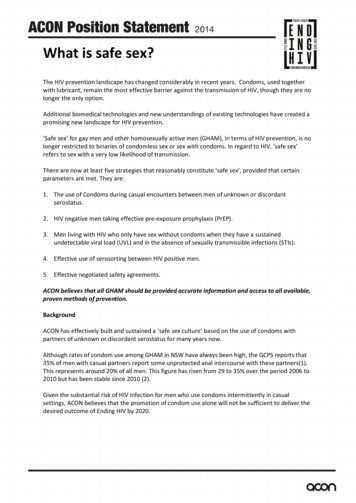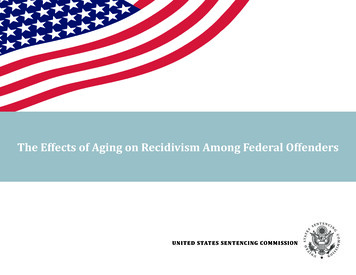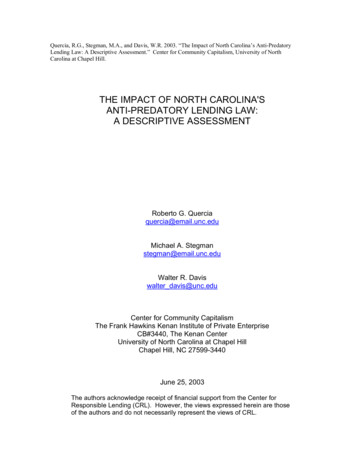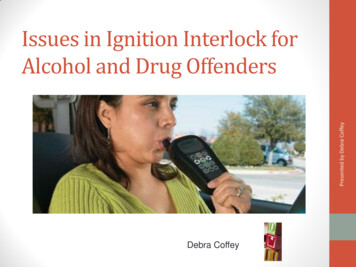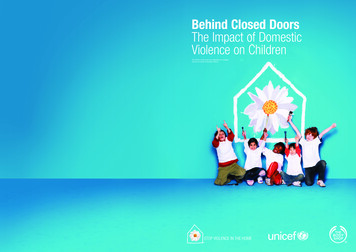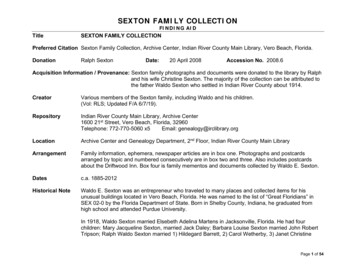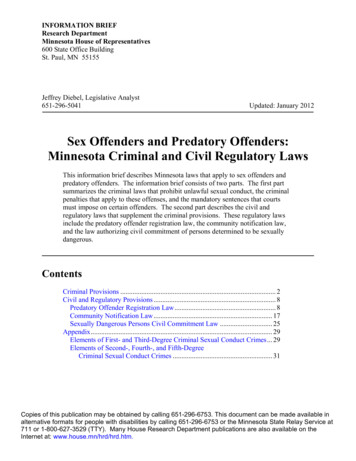
Transcription
INFORMATION BRIEFResearch DepartmentMinnesota House of Representatives600 State Office BuildingSt. Paul, MN 55155Jeffrey Diebel, Legislative Analyst651-296-5041Updated: January 2012Sex Offenders and Predatory Offenders:Minnesota Criminal and Civil Regulatory LawsThis information brief describes Minnesota laws that apply to sex offenders andpredatory offenders. The information brief consists of two parts. The first partsummarizes the criminal laws that prohibit unlawful sexual conduct, the criminalpenalties that apply to these offenses, and the mandatory sentences that courtsmust impose on certain offenders. The second part describes the civil andregulatory laws that supplement the criminal provisions. These regulatory lawsinclude the predatory offender registration law, the community notification law,and the law authorizing civil commitment of persons determined to be sexuallydangerous.ContentsCriminal Provisions . 2Civil and Regulatory Provisions . 8Predatory Offender Registration Law . 8Community Notification Law . 17Sexually Dangerous Persons Civil Commitment Law . 25Appendix . 29Elements of First- and Third-Degree Criminal Sexual Conduct Crimes . 29Elements of Second-, Fourth-, and Fifth-DegreeCriminal Sexual Conduct Crimes . 31Copies of this publication may be obtained by calling 651-296-6753. This document can be made available inalternative formats for people with disabilities by calling 651-296-6753 or the Minnesota State Relay Service at711 or 1-800-627-3529 (TTY). Many House Research Department publications are also available on theInternet at: www.house.mn/hrd/hrd.htm.
House Research DepartmentSex Offenders and Predatory OffendersUpdated: January 2012Page 2Criminal ProvisionsThe Elements of Criminal Sexual ConductMinnesota law classifies criminal sexual conduct into five categories: first- through fifth-degreecriminal sexual conduct. Each degree of the crime covers a variety of behavior, with first-degreecarrying the most severe penalties and fifth-degree the least severe. Generally speaking, thefirst-degree and third-degree crimes apply to sexual conduct involving sexual penetration of thevictim; the second-, fourth-, and fifth-degree crimes apply to sexual conduct involving sexualcontact with the victim without sexual penetration.The elements of the criminal sexual conduct crimes also vary with respect to a number of otherissues. For example, criminal sexual conduct in the first and second degree typically apply toconduct involving personal injury to the victim; the use or threatened use of force, violence, or adangerous weapon; or victims who are extremely young. Criminal sexual conduct in the third,fourth, and fifth degree typically address less aggravated conduct and apply to other situations inwhich the victim either did not consent to the sexual conduct, was relatively young, or wasincapable of voluntarily consenting to the sexual conduct due to a particular vulnerability or dueto the special relationship between the offender and the victim. Minn. Stat. §§ 609.342 to609.3451.The appendix contains detailed charts describing the specific elements of each degree of thecriminal sexual conduct crimes.Penalties for Criminal Sexual ConductCriminal sexual conduct in the first, second, third, and fourth degree are felony-level offenses.Criminal sexual conduct in the fifth degree is a gross misdemeanor offense; however, certainrepeat violations of this crime are classified as felonies. Minn. Stat. §§ 609.342 to 609.3451.The chart on the following page displays the maximum statutory penalty for each degree of thecrime and the presumptive sentence for each degree of the crime under the sentencing guidelinessex offender grid.
House Research DepartmentSex Offenders and Predatory OffendersName of crimestType of activityUpdated: January 2012Page 3Maximum penaltyprovided by statutePresumptive Sentencing Guidelinessentence (no criminal history)1 degreecriminal sexualconductSexual penetration;certain sexual contactwith victim under 13years old30 years; 40,000 fine144 months in prison; Statutory lawpresumes an executed sentence of 144months for all violations2nd degreecriminal sexualconductSexual contact25 years; 35,000 fine90 months in prison; 36 months stayedsentence for “statutory rape.”* Statutorylaw presumes an executed sentence of 90months for crimes where the perpetratoruses or threatens to use force or violence,causes injury, uses a dangerous weapon, orcreates significant fear on the part of thevictim of imminent great bodily harm3rd degreecriminal sexualconductSexual penetration15 years; 30,000 fine48 months in prison; 36 months stayedsentence for “statutory rape”*4th degreecriminal sexualconductSexual contact10 years; 20,000 fine24 months stayed sentence; 18 monthsstayed sentence for “statutory rape”*5th degreecriminal sexualconductSexual contact;certain lewd conductOne year; 3,000 fine(gross misdemeanor).Certain repeatviolations punishableby 5 years; 10,000fine15 months stayed sentence; Sentencingguidelines do not apply to grossmisdemeanor violations*As used in this chart, “statutory rape” means a criminal sexual conduct crime that has the following elements:(1) sexual conduct; (2) a victim of a certain age; and, for certain crimes, either (3) a familial relationship betweenthe actor and the victim; or (4) use of a position of authority by the actor. The term “statutory rape” is not a termused in statute.Mandatory Minimum Criminal PenaltiesThere are a number of mandatory minimum criminal penalties that apply to certain criminalsexual conduct offenses. These mandatory sentencing provisions are described below.First-Degree Criminal Sexual Conduct Offenders. The court must presume that an executedsentence of 144 months applies to any offender convicted of first-degree criminal sexualconduct. This penalty does not apply if a longer mandatory minimum sentence is otherwiserequired or the sentencing guidelines presume a longer executed sentence. If the court sentencesan offender in a manner other than as provided by this law, the sentence is a departure under thesentencing guidelines, requiring the court to make certain findings. Minn. Stat. § 609.342,subd. 2.
House Research DepartmentSex Offenders and Predatory OffendersUpdated: January 2012Page 4Certain Second-Degree Criminal Sexual Conduct Offenders. The court must presume that anexecuted sentence of 90 months applies to any offender convicted of second-degree criminalsexual conduct when the actor: uses or threatens use of force or violence,causes injury to the complainant,uses a dangerous weapon,creates significant fear on the part of the complainant of imminent great bodily harm,commits the crime with an accomplice, orhas a significant relationship to complainant under the age of 16.The presumptive executed sentence does not apply to other second-degree criminal sexualconduct offenses.This penalty does not apply if a longer mandatory minimum sentence is otherwise required bylaw or the sentencing guidelines presume a longer executed sentence. If the court sentences anoffender in a manner other than as provided by this law, the sentence is a departure under thesentencing guidelines, requiring the court to make certain findings. Minn. Stat. § 609.343, subd.2.Sentences for Repeat or Violent Predatory Offenders1Life Without Release. The court must impose a life-without-release sentence on a personconvicted of certain clauses2 of first- or second-degree criminal sexual conduct involving forceor violence, and either: the fact finder (i.e., the judge or jury) determined beyond a reasonable doubt that two ormore heinous3 elements exist, or the offender has a previous sex offense for first-,second-, or third-degree criminal sexual conduct and the fact finder determines that aheinous element exists for the present offense. Minn. Stat. § 609.3455, subd. 2.1Portions of this provision were previously found in Minnesota Statutes 2004, section 609.109, which appliedto offenses that occurred prior to 2005.2The clauses include: (1) where circumstances exist that cause the victim to have a reasonable fear of greatbodily harm; (2) where the offender is armed with a dangerous weapon; (3) where the offender causes personalinjury to the victim under specified conditions; (4) where the offender is aided or abetted by one or moreaccomplices under specified conditions; or (5) where the offender has a family-type relationship to a victim under 16and specified conditions exist.3A “heinous element” includes: (1) the offender tortured the victim; (2) the offender intentionally inflictedgreat bodily harm upon the victim; (3) the offender intentionally mutilated the victim; (4) the offender exposed thevictim to extreme inhuman conditions; (5) the offender was armed with a dangerous weapon and used or threatenedto use it to cause the victim to submit; (6) the offense involved sexual penetration or sexual contact with more thanone victim; (7) the offense involved more than one perpetrator engaging in sexual penetration or sexual contact withthe victim; or (8) the offender removed the victim from one place to another without his or her consent and did notrelease the victim in a safe place.
House Research DepartmentSex Offenders and Predatory OffendersUpdated: January 2012Page 5Indeterminate Life Sentence. The court must impose an indeterminate life sentence foroffenders who are convicted of certain clauses of first- or second-degree criminal sexual conduct(the same clauses referred to above) and the fact finder determines that a heinous element exists.Minn. Stat. § 609.3455, subd. 3.The court must also impose an indeterminate life sentence on offenders who are convicted offirst- through fourth-degree criminal sexual conduct or criminal sexual predatory conduct if oneof the three following conditions exist: The offender has two previous sex offense convictionsThe offender has one previous offense conviction and: the fact finder determines that the present offense involved an aggravating factor thatwould provide grounds for an upward durational departure; the person received an upward durational departure for the previous sex offenseconviction or was sentenced under the patterned and predatory sex offendersentencing law for the previous sex offense conviction; or the person was sentenced as a dangerous sex offender or as a patterned and predatorysex offender for the previous sex offense convictionThe offender has two prior sex offense convictions and the fact finder determines that theprior convictions and present offense involved at least three separate victims; and the fact finder determines that the present offense involved an aggravating factor thatwould provide grounds for an upward durational departure; the offender received an upward durational departure for one of the prior sex offenseconvictions or was sentenced under the patterned and predatory offender sentencinglaw for one of the prior sex offense convictions; or the person was sentenced as a dangerous sex offender or as a patterned and predatorysex offender for the previous sex offense convictionHowever, if the present offense is for fourth-degree criminal sexual conduct, then the offender isnot typically subject to the indeterminate life sentence. An indeterminate sentence can beimposed if the offender’s previous or prior sex offense convictions that are being used toenhance the sentence were for first- through third-degree criminal sexual conduct, criminalsexual predatory conduct, or crimes under any similar United States or state criminal statute.Minn. Stat. § 609.3455, subd. 4.Certain Engrained Offenders.4 The court must sentence an offender to at least twice thepresumptive prison sentence, and not more than the statutory maximum, if: 4the offender is convicted of committing or attempting to commit first- through fourthdegree criminal sexual conduct or criminal sexual predatory conduct;the fact finder determines that the offender is a danger to public safety; andPortions of this provision were previously found in Minnesota Statutes 2004, section 609.108. If an offenderwas convicted as a patterned predatory offender under Minnesota Statutes 2004, section 609.108, for crimescommitted before August 1, 2005, then that statute still applies. Minn. Stat. § 609.3455, subd. 9.
House Research DepartmentSex Offenders and Predatory Offenders Updated: January 2012Page 6the fact finder determines that the offender’s criminal sexual behavior is so engrained thatthe risk of reoffending is great without intensive treatment or supervision extendingbeyond the presumptive term of imprisonment and supervised release.Minn. Stat. § 609.3455, subd. 3a.Criminal Sexual Predatory Conduct. A person is guilty of criminal sexual predatory conduct ifthe crime was motivated by the offender’s sexual impulses or was part of a predatory pattern ofbehavior that had criminal sexual conduct as its goal. The sentence must be 25 percent longerthan for the underlying predatory crime; or 50 percent longer if the offender has a previous sexoffense conviction. Minn. Stat. § 609.3453.Mandatory Minimum Fines for Repeat and Violent OffendersIn addition to the mandatory sentencing provisions, mandatory minimum fines apply to allpersons convicted of criminal sexual conduct. These minimum fines are equal to 30 percent ofthe maximum fine authorized by law for the crime of conviction. The court may not waive theminimum fine, but may reduce it to not less than 50 or allow payment of the fine in installmentsdue to the offender’s indigency. In cases of indigency, the court also may order an offender toperform community work service in lieu of paying the fine. The court must forward 70 percentof the minimum fine to local programs that serve victims of sexual assault and the remainder tothe state general fund. If there are no local programs in the court’s jurisdiction, the entireminimum fine must be forwarded to the state general fund. Minn. Stat. § 609.101.Other Mandatory Sentencing ProvisionsConvicted predatory offenders also are subject to several other mandatory sentencing laws thatare designed to minimize their recidivism risk.Minimum Conditional Release Term. If a court sentences a felony-level sex offender toprison, the court must also sentence the offender to serve a minimum period of “conditionalrelease” after release from prison. All offenders are placed on conditional release for ten years.Offenders who were sentenced to an indeterminate life sentence (discussed above) and certainrepeat offenders are placed on conditional release for the remainder of his or her life. The repeatoffenders subject to lifetime conditional release are those that are released from prison for firstthrough fourth-degree criminal sexual conduct or criminal sexual predatory conduct, and theoffender had a previous5 or prior6 sex offense conviction. But if the offender is released from5A conviction is considered a “previous” sex offense conviction if the offender was convicted and sentencedfor a sex offense before the commission of the present offense. Minn. Stat. § 609.3455, subd. 1, para. (f).6A conviction is considered a “prior” sex offense conviction if the offender was convicted of committing a sexoffense before the offender has been convicted of the present offense, regardless of whether the offender wasconvicted for the first offense before the commission of the present offense, and the convictions involved separatebehavioral incidents. Minn. Stat. § 609.3455, subd. 1, para. (g). A “prior” sex offense conviction does not requirethe sequencing of events that a “previous” sex offense conviction does. Thus, a person who has committed two sexoffenses but has not been convicted of either would be considered to have a prior sex offense once the offender has
House Research DepartmentSex Offenders and Predatory OffendersUpdated: January 2012Page 7prison for fourth-degree criminal sexual conduct, the offender will only be placed on lifetimeconditional release if the offender’s previous or prior sex offense conviction being used as thebasis for the lifetime conditional release terms, is for first- through third-degree criminal sexualconduct or criminal sexual predatory conduct. Minn. Stat. § 609.3455, subds. 6 and 7.Mandatory Predatory Offender Assessment and Treatment. The court must order apredatory offender treatment assessment for any person convicted of criminal sexual conduct(any degree), surreptitious intrusion, obscene phone calls, or indecent exposure. The court maywaive the assessment if the offender is eligible for a presumptive prison sentence or has alreadybeen assessed.If the assessment indicates the offender is in need of and amenable to treatment, the court mustorder the offender to undergo treatment if the court places the offender on probation. Minn. Stat.§ 609.3457.DNA Analysis. The court must order persons convicted of or adjudicated for a sex offense toprovide a biological sample for DNA analysis, if the offender has not already done so. Thisrequirement also applies to persons convicted of other violent crimes listed in the law. If anindividual was not ordered to provide this specimen at the time of sentencing, the offender mustprovide the specimen before release. An offender who is incarcerated for any offense and whohas a conviction for a prior offense enumerated in the law must provide a specimen beforerelease, even if the offense for which the person is currently serving time is not an offenseenumerated in the law. Minn. Stat. § 609.117.been convicted for the first offense even though the present offense occurred before the actual conviction for theprior offense.
House Research DepartmentSex Offenders and Predatory OffendersUpdated: January 2012Page 8Civil and Regulatory ProvisionsPredatory Offender Registration LawThe predatory offender registration law requires registration of individuals who have committedcertain crimes under Minnesota law, federal law, or the law of other states. The law also requiresregistration of certain individuals who have been civilly committed.Offenders Who Commit Offenses in Minnesota. An adult who is charged with and convictedof, or a juvenile who is petitioned for and adjudicated delinquent for, one of the followingoffenses or another offense arising out of the same set of circumstances, must register under thelaw: murder while committing or attempting to commit criminal sexual conduct in the first orsecond degree with force or violencekidnappingcriminal sexual conduct in the first, second, third, and fourth degree and felony criminalsexual conduct in the fifth degreecriminal sexual predatory conductfelony indecent exposurefalse imprisonment of a minorsoliciting a minor to engage in prostitutionsoliciting a minor to engage in sexual conductusing a minor in a sexual performancepossessing pictorial representations of minorsAn adult also must register under the law if sentenced as an engrained sex offender underMinnesota Statutes, section 609.3455, subdivision 3a. Minn. Stat. § 243.166, subd. 1b.Offenders Who Commit Offenses under United States Law. An adult or juvenile mustregister if convicted of or adjudicated delinquent for violating a law of the United States similarto any of the above laws. An adult or juvenile also must register if convicted of or adjudicateddelinquent for an offense pursuant to court martial for violating a law of the United States,including the Uniform Code of Military Justice, similar to any of the above laws. Minn. Stat.§ 243.166, subd. 1b.Offenders Who Commit Offenses in Other States. A person who was convicted in anotherstate for an offense that would be a violation of one of the above laws if committed in this statemust register if the person enters the state to reside, work, or attend school, or enters this stateand remains for 14 days or longer.7 The person must register in Minnesota if ten years have not7A “school” is any public or private educational institution, including any secondary school, trade orprofessional institution, or institution of higher education, that the person is enrolled in on a full-time or part-timebasis. “Work” means employment that is full-time or part-time for a period of time exceeding 14 days or for anaggregate period of time exceeding 30 days during any calendar year, whether financially compensated, volunteered,or for the purpose of government or educational benefit.
House Research DepartmentSex Offenders and Predatory OffendersUpdated: January 2012Page 9elapsed since the person was released from confinement or, if the person was not confined, sincethe person was convicted of the offense-triggering registration. This ten-year limit is notapplicable to those subject to a longer registration period under the laws of the other state inwhich the person has been convicted, or those subject to lifetime registration; these offendersmust register for that longer time period or for life regardless of when they were released fromconfinement or convicted. This requirement also applies to juvenile offenders whose cases arehandled in the juvenile justice system. If the offender leaves Minnesota or is no longer workingor attending school in Minnesota, the offender is no longer subject to Minnesota’s registrationlaw. Minn. Stat. § 243.166, subd. 1b.Individuals Civilly Committed Regardless of Whether Convicted for an Offense. A personmust register under the law if the person was committed as a sexually dangerous person, sexualpsychopath, or psychopathic personality under Minnesota Statutes 1992, section 526.10, or asimilar law of another state or the United States, regardless of whether the person was convictedfor an offense.A person also must register under the law if: the person was charged with or petitioned for a specific offense listed in the predatoryoffender registration law or the similar law of another state or the United States;the person was found not guilty by reason of mental illness or mental deficiency after atrial for the offense, or found guilty but mentally ill after a trial for that offense; andthe person was committed pursuant to a court commitment order.Minn. Stat. § 243.166, subd. 1b.Individuals Who Commit Other Offenses. The predatory offender registration law alsoapplies to certain individuals who commit a crime against the person that may not be includedwithin the scope of the predatory offender registration law. This registration requirement appliesif the person is convicted of a crime against the person and: the person was previously convicted of or adjudicated delinquent for an offense for whichregistration is currently required, or a comparable offense in another state, but was notrequired to register for the offense because the registration requirements did not apply tothe person at the time the offense was committed or at the time the person was releasedfrom imprisonment; orthe person was previously required to register under the predatory offender registrationlaw and has completed the registration requirements.Minn. Stat. § 243.167.A crime against the person is defined to mean certain crimes involving firearms by personsineligible to possess firearms; first-, second-, and third-degree murder; manslaughter in the firstand second degree; first-, second-, third-, fourth-, and fifth-degree (gross misdemeanor andfelony) assault; gross misdemeanor and felony domestic assault; domestic abuse bystrangulation; use of drugs to facilitate crime; aggravated robbery in the first degree; kidnapping,
House Research DepartmentSex Offenders and Predatory OffendersUpdated: January 2012Page 10false imprisonment; felony fifth-degree criminal sexual conduct; tampering with a witness in thefirst degree; burglary in the first degree; gross misdemeanor indecent exposure; and any felonylevel violation of a crime committed for the benefit of a gang, malicious punishment of a child,or involving stalking or harassment. The definition includes violations of these Minnesota lawsand violations of similar laws of other states or the United States. Minn. Stat. § 243.167, subd.1.Notifying an Offender of the Obligation to RegisterThe court must inform a person who is required to register of the duty to register and require theperson to read and sign a form stating that the duty of the person to register under this section hasbeen explained. The court also must inform the person that, if the person fails to comply withthe registration requirements, information about the offender may be made available to the publicthrough electronic, computerized, or other accessible means. The court lacks authority to modifythe person’s duty to register. The court must forward the signed predatory offender registrationform, the complaint, and sentencing documents to the Bureau of Criminal Apprehension (BCA).If the court does not notify the person of the registration requirement, the assigned correctionsagent shall notify the person of the registration requirements. If the person is required to registerfollowing release from civil commitment, the treatment facility shall notify the person of theregistration requirements, obtain the required registration information, and forward theinformation to the BCA. Minn. Stat. § 243.166, subd. 2.The person’s corrections agent, or if the person does not have an assigned corrections agent, thelaw enforcement authority with jurisdiction in the area of the person’s primary address mustnotify the person of the obligation to register in another state if the person works or attendsschool there. Minn. Stat. § 243.166, subd. 3.Information Required at Initial RegistrationThe initial registration must include a written statement signed by the person giving informationrequired by the BCA, a fingerprint card, and a photograph of the person taken at the time of theperson’s release from incarceration, or if the person was not incarcerated, at the time the personinitially registered. The registration information also must include a written consent form signedby the person allowing a treatment facility or residential housing unit or shelter to releaseinformation to law enforcement about the person’s admission to, or residence in, such facility.Minn. Stat. § 243.166, subd. 4.An individual also must provide the following information to the corrections agent or lawenforcement authority: the person’s primary addressall the person’s secondary addresses in Minnesota, including all addresses used forresidential or recreational purposesthe addresses of all Minnesota property owned, leased, or rented by the person
House Research DepartmentSex Offenders and Predatory OffendersUpdated: January 2012Page 11the addresses of all locations where the person is employedthe addresses of all schools where the person is enrolledthe year, model, make, license plate number, and color of all motor vehicles8 owned orregularly driven by the person An individual must notify law enforcement at least five days before living at a new primaryaddress. An individual must report the other information noted above within five days of thetime it becomes applicable. The individual must immediately inform law enforcement when anyreported information is no longer applicable. There are different registration procedures forpersons who lack a primary address (discussed below). Minn. Stat. § 243.166, subds. 3 and 4a.The registration information for a person who is required to register due to court commitment asa sexually dangerous person or sexual psychopathic personality must also include the person’soffense history and documentation of treatment received during the person’s confinement. Thisdocument is limited to a statement of how far the person progressed in treatment duringconfinement. Minn. Stat. § 243.166, subd. 4.Continuing Obligations of the Registration LawA person must continue to update his or her assigned corrections agent or the law enforcementauthority with which he or she currently is registered of changes in primary address and otherinformation required to be provided. This notice must be provided at least five days before theperson starts living at the new address.If the person will be living in a new state and that state has a registration requirement, he or shemust also give written notice of the new address to the designated registration agency in the newstate.A person who is required to register because of working or attending school in Minnesota mustregister with the law enforcement authority that has jurisdiction in the area where the personworks or attends school. This registration must occur within five days of beginning employmentor school. The person must provide the address of the school or the location where he or she isemployed.A person who is required to register in Minnesota who works or attends school outside ofMinnesota must register in the state where he or she works or attends school. Minn. Stat. §243.166, subd. 3.The corrections agent or law enforcement authority must require a level III offender to appear atleast every six months to be photographed, except during any period where the person to bephotographed is incarcerated or receiving treatment in a secure treatment facility. The agent orauthority may also require any other person who is required to register to appear for a8Motor vehicle means “every vehicle which is self-propelled and every vehicle which is propelled by electricpower obtained from overhead trolley wires.” Minn. Stat. § 169.011, subd. 42. Motor
St. Paul, MN 55155 Jeffrey Diebel, Legislative Analyst 651-296-5041 Updated: January 2012 Sex Offenders and Predatory Offenders: . accomplices under specified conditions; or (5) where the offender has a family-type relationship to a victim under 16 and specified conditions exist.
